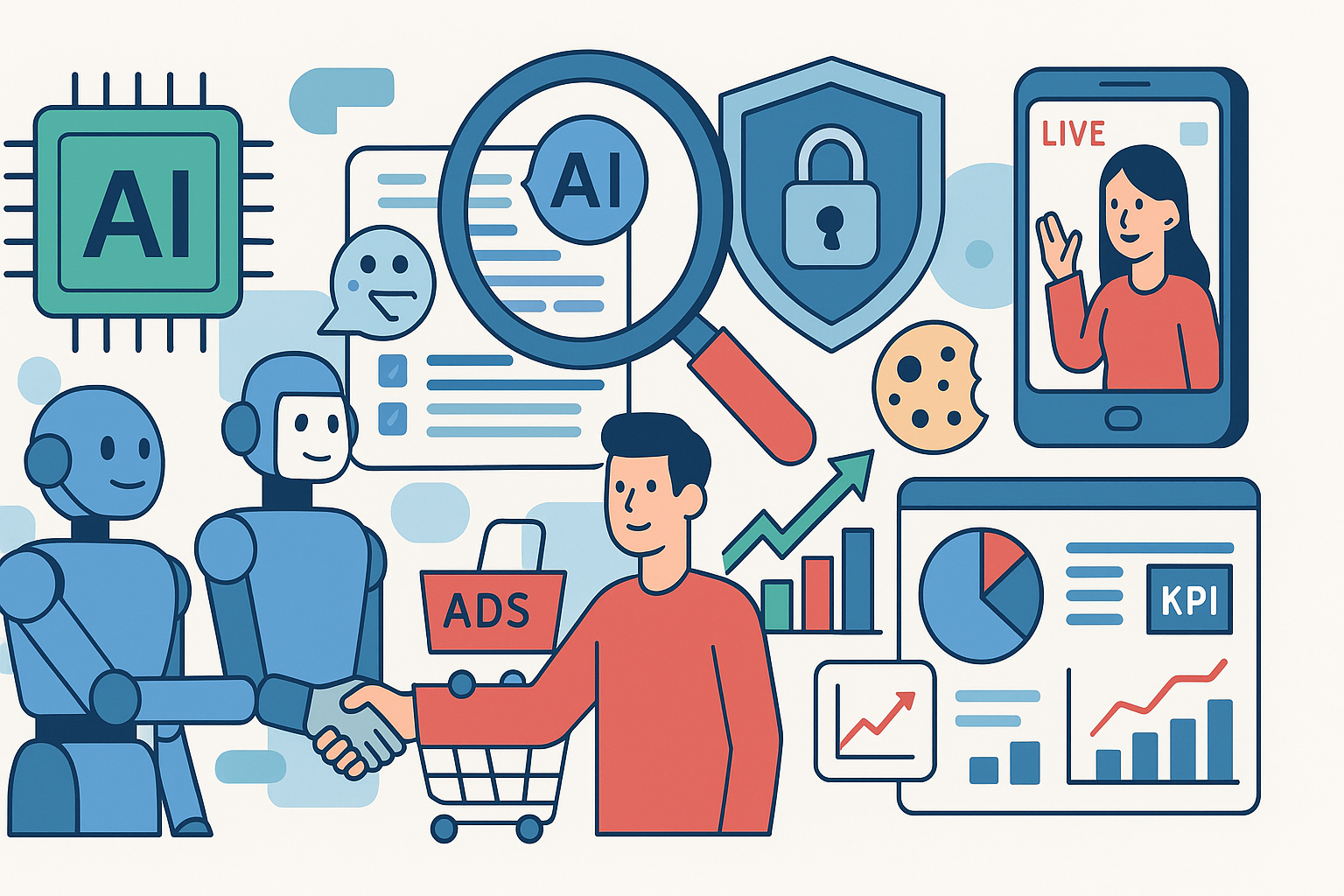TL;DR: 2025 is the year marketers operationalize AI, rebuild measurement for a privacy-first web, go full-funnel with retail media, and adapt content for search that’s increasingly generative and zero-click. Here’s what matters—and exactly how to respond.
1) AI becomes the operating system of marketing (not just a tool)
AI has moved from isolated pilots to workflow-deep adoption across research, planning, creative, media, and customer ops. Leading stacks now combine proprietary customer data with AI “agents” that brief, produce, and optimize—under human supervision. HubSpot’s latest releases are a good bellwether: AI agents tied to a central data hub, built for real team workflows and measurable goals. Investors.com
Move now
- Wire AI into your existing processes: campaign briefs → asset generation → QA → performance loops.
- Build a governed “marketing data layer” (CDP + consent + clean rooms) to feed AI safely.
- Set guardrails (prompts, style guides, approvals) and measure AI’s incremental lift.
2) Search is changing: optimize for AI answers, not just blue links
Google’s AI-driven Search Generative Experience (SGE) and wider zero-click patterns mean more answers appear before a visit to your site. Marketers who treat AI summaries as a new “placement” win visibility with structured, authoritative content and rich product data. Expect continual SERP volatility as SGE rolls out and evolves. eintelligenceweb.comTerra
Move now
- Publish intent-clustered hubs with concise, citation-ready sections (great for AI summaries).
- Double down on structured data (Product, Review, HowTo, FAQ) and first-party imagery/specs.
- Track “assisted exposure” with impression proxies (rank volatility, FAQ surfacing, brand mention monitoring), not just sessions.
Bonus stat to watch: analysts have forecast a drop in traditional search volume as AI assistants capture more queries—plan channel mix accordingly. yesandbeacon.com
3) Privacy-first reality: third-party cookies are fading, grace periods are finite
Chrome’s third-party cookie phase-out continues under the Privacy Sandbox, with mechanisms like a grace period for breakage but a clear direction: fewer cross-site identifiers, more privacy-preserving APIs. Marketers must shift targeting and measurement to first-party data, contextual, and modeled conversions. Privacy SandboxPrivacy SandboxGoogle Help
Move now
- Maximize first-party consent: value exchanges, preference centers, and server-side tagging.
- Test Sandbox APIs and conversion modeling with your ad platforms.
- Rebalance measurement: MMM + incrementality testing + platform clean rooms.
4) Retail media grows up—and goes full-funnel
Retail media networks (RMNs) keep expanding because they combine high-intent audiences with rich first-party purchase data. 2025’s shift is from on-site sponsored listings to full-funnel: off-site programmatic, CTV, and in-store attribution tied together. Advertisers are leaning in—but scrutiny on performance and transparency is rising. NielsenDigiday
We’re also seeing non-traditional retailers (e-grocery, q-commerce) stand up ad businesses to diversify revenue—evidence that RMN is a durable line item, not a fad. Reuters
Move now
- Pilot two RMNs per category: one incumbent + one challenger; compare incrementality.
- Feed them rich creative variants and product feeds (availability, price, promos) for better ROAS.
- Connect RMN reporting to your BI: track halo on search, brand lift, and repeat purchase.
5) The creator economy adds AI-native influencers
AI-generated creators are entering media plans with speed and scale benefits (24/7 production, precise brand control). Yet authenticity gaps remain and human creators still tend to outperform on engagement and trust. Expect hybrid programs where AI personas handle evergreen explainers while human creators deliver story and community. Financial Times
Move now
- Label AI content clearly; codify disclosure in your brand safety policy.
- Test A/B: AI explainer vs. human creator; evaluate not just CTR but save/share rates and assisted conversions.
- Build creator briefs that include talking points and model guardrails (voice, tone, likeness rights).
6) Total video & social commerce converge
“Total video” planning—spanning vertical short-form, YouTube/CTV, and social live—keeps consolidating. Livestream shopping and shoppable CTV are maturing as retailers and social platforms integrate catalogs and checkout. Treat content as modular: the same narrative, cut for Shorts/Reels, long-form proof, and CTV reach, then closed with retail media retargeting. Kantar
Move now
- Design a core storyline with platform-specific edits (6s hook, 15s social, 90s explainer, 15-sec CTV).
- Enable shoppability everywhere (product feeds, deep links, affiliate IDs).
- Attribute with experiments: geo-splits or time-boxed CTV bursts tied to site lift and RMN sales.
7) From dashboards to decisions: measurement gets practical
As cookies fade and AI content scales, the winners operationalize mixed measurement: platform lift studies, MMM for budgeting, and experiment frameworks the team actually runs. Tooling matters less than cadence: weekly experiments, quarterly model refresh, and “narrative reporting” that explains what to do next.
Move now
- Maintain an experimentation backlog with hypotheses, sample sizes, and owners.
- Standardize KPI ladders (business → channel → creative) and keep a living “what works” playbook.
- Present decisions, not charts: what we’ll stop, start, and scale this month.
Your 30-day action plan
- Audit: Map AI use across your funnel; identify two manual steps to automate first. Investors.com
- Search reset: Convert top 10 articles into SGE-friendly, structured hubs with crisp summaries and FAQs. eintelligenceweb.com
- Privacy prep: Verify consent capture, enable server-side tagging, and pilot at least one Sandbox API with your ad partner. Privacy SandboxPrivacy Sandbox
- Retail media test: Launch a two-network test with clean incrementality design and unified reporting. NielsenDigiday
- Creator mix: Run a small AI-vs-human creator split test with transparent labeling and safety review. Financial Times
Bottom line
2025 rewards marketers who operationalize AI, own their data, and treat channels as a connected system—from AI answers in search to cart in a retailer’s app. Build for clarity, speed, and proof—and you’ll outpace the field.
